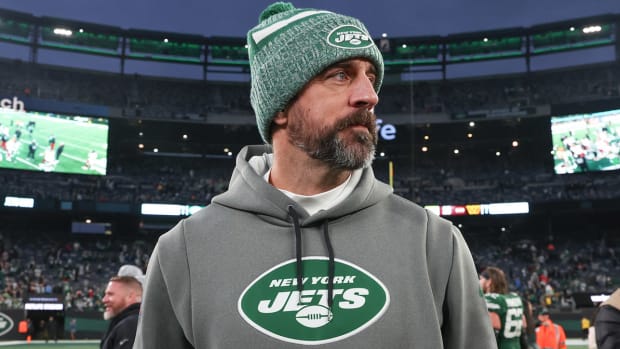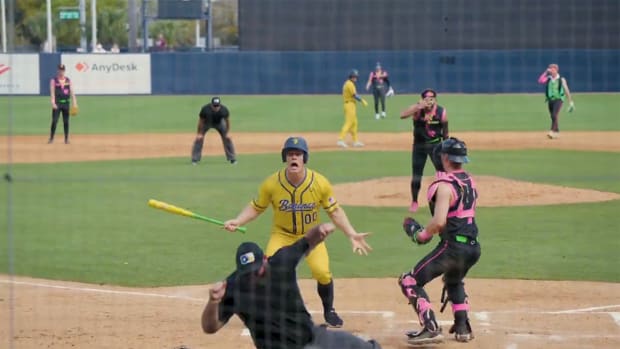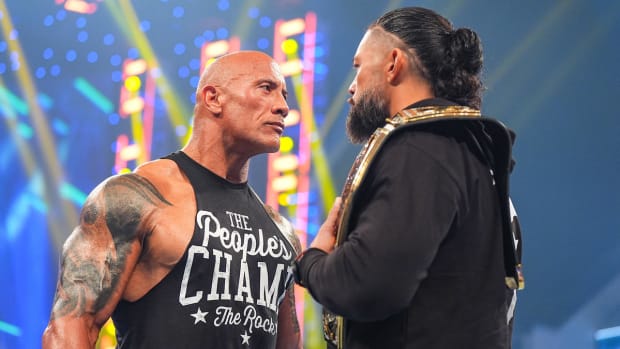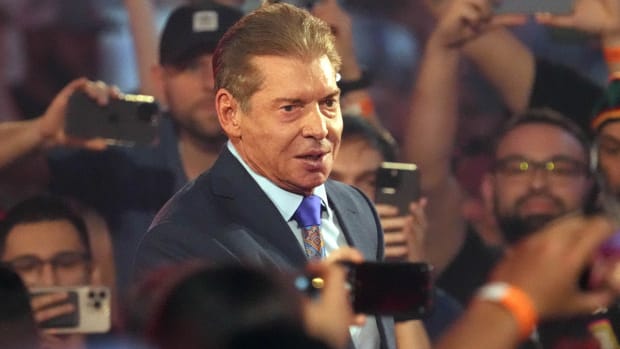How the NWO Shocked the World and Changed the Wrestling Business Forever
July 7, 1996.
At World Championship Wrestling’s Bash at the Beach, an unthinkable heel turn changed the industry forever. The massive chance taken that night is in many ways responsible for modern wrestling’s story lines, place in pop culture and enduring nostalgic appeal.
In the main event of the Bash, Hulk Hogan revealed himself as the mysterious third member of Kevin Nash and Scott Hall’s team, turning to the dark side and spitting in the face of his longtime fans. As fans showered the ring with heaps of debris, Hogan and Gene Okerlund, a pair famous for their interviews in the glory days of the World Wrestling Federation, stood beside each other. Hogan let it be known that he was the man responsible for the WWF phenomenon, and then proclaimed the birth of a new world order in professional wrestling.
The New World Order.
The NWO.
And they weren’t kidding when they said membership was for life.
Twenty-five years later, Hogan’s turn remains among the most titanic moments in the history of the industry, and the formation of the NWO still serves as its most powerful development. Hogan turned heel, shredding the trademark red and gold for a new look of black and white. Joining forces with Nash and Hall, who were a rare combination of legitimate tough guys who were as dangerous as they were entertaining, the moment was the start of something larger that had industry-altering ramifications.
“The NWO changed the business,” says Paul Wight, who was part of the NWO during his days in WCW as The Giant, before starring in WWE as The Big Show. “They made it possible for heels to be cool.”
NWO T-shirts are still top sellers. The “Too Sweet” hand gesture is a fixture among both talent and fans. What transpired following Hogan’s leg drop on Randy Savage reverberated through living rooms, then extended across pro wrestling and into other pro sports.
Capitalizing upon the WWE-WCW battle, Hall delivered a convincing performance from the moment he first appeared on Nitro, suggesting he was sent by Vince McMahon to wreak carnage on their rival.
“It was a different time,” Hall says. “The internet was not as prominent as today. People thought it was real. Other WCW wrestlers thought it was real. We sold the story that Vince sent me and Kev to join Hulk and cancel WCW.”
As The Giant, Wight was WCW champion the night of Bash at the Beach, but his tag match is merely a footnote to the main event. Now a lead commentator in All Elite Wrestling for AEW Dark: Elevation, Wight still recalls the visceral reaction when Hogan was revealed as Hall and Nash’s third man.
“The reaction of the crowd that night of the pay per view told us something different was happening,” Wight says. “The anti-hero became the hero, and that was a direct parallel to what was happening in society. And so much of that night was unpredictable.”
The air of the unknown permeated every moment of preparation for Hall and Nash’s match against Sting, Lex Luger and Savage at Bash at the Beach. No one knew exactly how the Hogan turn would play out—or whether it would even occur, let alone become such a lasting memory for so many.
Hall had arrived in WCW in May of ’96, emerging from the crowd on an episode of Nitro. In an era when WWE was pre-taping much of its programming and genuine surprises were rare, his appearance sent shockwaves throughout wrestling. Two weeks later, Nash also arrived, displaying a striking realism that was simply not present at the time in WWE. Hall claimed they were “taking over,” a stroke of genius considering it implied that they were sent from Vince McMahon’s WWE. Together as The Outsiders, Hall and Nash did the seemingly impossible by being equal parts threatening, charming and intimidating, using the equity they had built in WWE to amplify their work in WCW. The match at Bash at the Beach was set to be their in-ring debut for their new employer.
“That was the first match [since signing in WCW],” Nash recalls. “We hadn’t worked in a while.”
Hall and Nash were playing the role of instigators and agitators, wreaking havoc in WCW, though they weren’t actually in wrestling matches. The last time they’d performed in the ring was May 19, 1996, at WWE’s Madison Square Garden show. That was the night of the infamous “Curtain Call,” which was their legitimate farewell from the company. They then arrived in a promotion that was in flux. The Giant was the reigning world champ, but his title reign wouldn’t last through the summer. Once he dropped the belt to Hogan at Hog Wild in August, he also began to incorporate more realism into his character, eventually joining the NWO that fall.
“My character at the time was cartoonish, but [joining the NWO] gave me an opportunity to connect with a character that was more me,” Wight says. “I was able to believe in what I did in a different way, becoming more real and more legitimate, and that helped me connect more with the audience.”
Throughout history, wrestling’s top stars have had to evolve to remain at the top of the industry. Chris Jericho has unveiled countless subtleties and nuances to his character throughout the years, as have John Cena, Roman Reigns, and Sasha Banks. Hogan in the red-and-yellow always seemed slightly out of place in WCW, but he became a WCW icon—even crossing over into mainstream sports and entertainment in matches that included Dennis Rodman, Karl Malone and Jay Leno—in this new black-and-white incarnation. Right from the start, the NWO represented a chance to add a new layer to the careers of Hogan, Hall and Nash.
“Joining the NWO revived Hogan’s career,” Wight says. “It’s one of those moments that you remember where you were when it happened, and it was equally as important for Kevin and Scott.
“All the taboo things you couldn’t touch, Kevin and Scott flipped them upside down. They made fun of the old regime. They did exactly what, supposedly, you weren’t allowed to do. I was so new to the business that I felt like a plastic bag in a tornado so often, I didn’t know what was going on. It was a hell of a time.”
Hogan had been a fixture in the world title picture since his arrival in the summer of 1994, but his tried-and-true message of saying your prayers and eating your vitamins no longer held the same gravitas by the midpoint of 1996. And with interest in Hogan waning, WCW president Eric Bischoff saw this as the perfect time to turn Hogan into wrestling’s premier villain.
“Wrestling had taken a downturn in the ’90s,” Bischoff says. “Vince McMahon had his issues with the steroid trials and the distractions with that. Everything was declining. In terms of live attendance, no one was drawing big numbers in the United States. I was visiting Japan and seeing packed crowds at the Tokyo Dome, so I studied the difference between what was being presented in America against what was in Japan. The biggest difference was that it was treated so real in Japan. I’m talking about the talent, the fans and even the media.
“So I had approached Hulk a little under a year earlier about turning heel and changing the direction of his character. He was not interested. During the next few months, it became a little more obvious to Hulk that the red-and-yellow guy from the ’80s wasn’t working any more. He knew it, I knew it, the fans knew it, but it took a few more months for him to realize it enough to make that change.”
With or without Hogan, a new group featuring Hall and Nash would be formed at Bash at the Beach. Bischoff honed in on Sting as the best fit for the third man.
Imagining Sting as the third man is one of wrestling’s most dizzying “What if?” moments. Sting certainly could have worked a convincing style as a heel, but Hall and Nash were cast perfectly as The Outsiders. On the other hand, Sting embodied WCW. It was a conundrum, and having Hogan eventually return in red-and-yellow to fight off Sting, Hall and Nash feels like merely a new twist on an old story. In an era where Bischoff craved a more reality-based product, having Hogan—the ultimate WCW outsider, who wasn’t far removed from a babyface title reign of 469 days—align with Hall and Nash felt extraordinary. Hogan was the face of the “golden era” of ’80s wrestling. He had crossed over into the mainstream during that period, and there is no one else who could have made that heel turn feel as substantial.
“It felt real because it was treated real,” Bischoff says. “Kevin and Scott coming allowed us to apply that kind of reality to the WCW product. Once Hulk made his decision, I knew it would be shocking and I knew he would be good at it. I just didn’t know if he’d follow through on the decision.”
“Since Hulk had previously expressed that he wasn’t interested, I approached Sting about being the third man. There are a lot of reasons why I have so much respect for Steve Borden, but one of the biggest reasons is—and I remember specifically talking to him on the phone while Hogan was off doing a movie—I asked Sting to abandon the babyface position he was in and take on that heel role, which was a big ask, and Sting was willing to do it. Kevin Nash and Scott Hall did not know who the third person was going to be. Sting and I were the only two people who knew. That’s when I got the phone call from Hulk, who was literally on location filming in the middle of some mountain range in California. He said, ‘Hey brother, I’d like to talk to you about what’s going on. Can you make it out to California?’ I said, ‘Sure, I’ll come out,’ and I came to his trailer, which was basically his dressing room and his office.
“We had a twelve pack of beer on ice and a couple Cuban cigars. We sat down, cracked a beer, lit a cigar, and he looked at me and asked, ‘Who’s the third guy?’ And I said, ‘I don’t know, Hulk. Who do you think it should be?’ Hulk said, ‘Well, I think it should be me.’ At the time, Hulk never knew it was going to be Sting—that’s how much of a secret that was.”
Hogan had remained a draw in WCW, but it had been a dozen years since he hit the famed leg drop on the Iron Sheik at Madison Square Garden to begin the commercial success of Hulkamania. The roots of that phenomenon were laid in the early ’80s in Minneapolis for the AWA, a promotion that was ultimately wiped out by its poor long-term planning coupled with the business savvy of WWE’s McMahon.
There were a few major reasons for Hogan’s split from McMahon in ’94, but ultimately McMahon thought Hogan was entering the twilight of his career. McMahon had appeared to be correct, until Hogan made that fateful walk to the ring at Bash at the Beach and breathed fresh air into his career.
“I knew I could work as a heel because I’d watched so much of Ray Stevens and Pat Patterson and ‘Superstar’ Billy Graham and The Great Malenko,” Hogan says. “They’d chop, kick and beat the crap out of you, but then they’d backpedal, cross their heart, and drop to their knees the moment the babyface would make his comeback. For me, the problem was the timing. I didn’t know if that was the right timing to do it.”
Traditionally, babyfaces were the top moneymakers in the wrestling business. Hogan had played a heroic babyface character for over a decade, and becoming a villain was a risk that came without a financial guarantee or the promise of the adulation of fans around the globe. But the momentum of Hall and Nash—which he was able to sense watching the videotapes of Nitro sent to him by Jimmy Hart while he was away filming his movie—was too strong to ignore.
“It wasn’t as intense as it was from ’89 to ’91, but there were still people who loved me as a babyface,” Hogan says. “I was so focused during that stretch with doing movies, and I still wanted to come back in the red and yellow. Eric had mentioned the idea to me, and I thought I could be a really intense heel. But turning, after all we’d been through to reach that point, it really concerned me.”
Amid the uncertainty, there was an overwhelming amount of optimism entering the pay-per-view. The WCW roster was loaded. Outside of the main event, Bash at the Beach featured the likes of Ric Flair, The Giant, a young Rey Mysterio, Konnan, Dean Malenko, Arn Anderson, former NFL player Steve McMichael and Dallas Page. Even the pre-show was phenomenal, with matches from Eddie Guerrero, Booker T, Billy Kidman, William Regal and Scott Steiner. Plus, Hall and Nash were entering the prime of their careers, with every promo redefining the way that top stars, especially heels, could interact with the crowd. There were genuine main-eventers in Savage and Sting, Luger had come in to his own and, of course, there was the fascination and intrigue over who would be the third man.
“Scott and I had talked to Eric a little bit about Sting being the alternative,” Nash says. “We didn’t know if it would be Hulk.”
Up until the night of the Bash, Bischoff says there was no guarantee that Hogan was going to reveal himself as Hall and Nash’s mysterious third partner in their match against Sting, Luger and Savage (each of whom, in a twist that no one could have predicted that night, would eventually join the NWO).
“I wasn’t 100% sure that Hulk was going to follow through until he literally showed up to the building,” Bischoff says. “I was nervous as hell, right up until he showed up and said, ‘Let’s do this, brother.’ ”
The main-event took an important turn when Sting accidentally knocked out Luger, turning the bout into a two-on-two affair.
“It wasn’t that great of a match,” Nash says. “Hulk coming down was just him coming down, but it was all about what happened after that.”
There was no turning back once Hogan started his stride down the aisle. Yet Hogan wasn’t thinking about the past decade of his success as a babyface, or his forthcoming promo, during his trek to the ring. Instead, he was in his own head questioning his decision to wear cowboy boots, lamenting the fact that he would have been far more comfortable—and confident—in his wrestling boots.
“I immediately worried it was going to be an angle alert,” Hogan says. “I was thinking that as soon as I was headed to the ring, telling myself I was an idiot for doing it. Those boots were really slippery, too, and I think you’ll see me grab the rope before I take a step and hit those leg drops on Randy. Had I been wearing my wrestling boots, it would have been a much bigger production. It was such a rookie move on my part.”
The footwear ultimately didn’t matter. The leg drop caused a visceral reaction that still seizes people’s attention a quarter century later.
“We needed a certain kind of heat,” Hogan says. “I was someone they had loved and believed in, so in order for this to work, there needed to be the right reaction. That’s what we got when people in the crowd started throwing water bottles, trash, and everything else at us in the ring. That’s what we needed, and we got it.”
Hogan, Hall and Nash in the ring together, as partners, was the defining moment of the show. But the idea that, 25 years later, it would still be a talking point for wrestling fans around the world was never even remotely considered.
“We knew we definitely had some heat in that building,” says Nash, who is reuniting with Hall for autograph signings this weekend (a virtual signing on Friday and in-person on Saturday in the morning and the afternoon). “But we didn’t know if it would transcend any further than that night.”
“I had hoped, initially, we’d get a successful six-to-eight-month story out of the NWO,” Bischoff adds. “I had no idea it would become as big as it became, and still is.”
Hogan is the subject of an upcoming Netflix biopic, directed by Todd Phillips and starring Chris Hemsworth as Hogan. With Bischoff serving as an executive producer, the project is yet another reminder of the enduring impact of the NWO. Bischoff also cohosts the popular 83 Weeks podcast, detailing his time in WCW and taking a zoomed-in look at the NWO’s story lines.
Wrestling, particularly in WWE, rarely takes chances of this magnitude. Jon Moxley’s arrival in AEW was a genuine surprise, but it is hard to replicate the shock inspired by the NWO on July 7, 1996. One reason the moment worked was that it was not overproduced.
“I didn’t want it to feel like we were shooting on a movie set, I wanted that lack of pre-production feel,” Bischoff says. “We wanted the viewer to feel like it was out of control.”
From the broadcast booth, Tony Schiavone saw the moment unfold with a unique perspective. A signature voice of pro wrestling, now working for AEW, Schiavone captured the raw emotion of the finish of Bash at the Beach by uttering the marvelous line, “Hulk Hogan, you can go to hell!” right before the show went off the air.
“When I walked backstage after the show, I passed Brian Knobbs, who is a friend of Hogan,” Schiavone says. “He looked at me and said, ‘Hulk Hogan, you can go to hell!’ That was f---ing great!’ I just thought it was something that felt right. I was there in WWE in 1989. I knew what he meant to the fans. As I’m watching this, I’m thinking, man, it’s one of the greatest heel turns ever, so I needed to sign off with something special.”
It felt frenetic, almost spontaneous.
“I still believe that the best work I can do as an announcer is when I cease to be an announcer and become a fan,” Schiavone says. “And as a fan, it was impossible not to be disappointed in Hogan.”
The presence of Gene Okerlund played an integral role. The established interviewer stepped into the ring, incredulous at Hogan for his nefarious actions.
“Hulk and Gene were connected back in the early days of Hulkamania, so he was the perfect person to say ‘Excuse me’ to Hogan,” Schiavone says. “He set that up in a way only Gene could, and that’s just another example that there was no one better than Gene.”
This was Hogan’s first promo as a heel, not quite yet “Hollywood” but firmly establishing himself as a villain.
“Gene was the right person to do it with,” Hogan says. “And I tried to stick with what I believed to be the truth. Years before, Eric Bischoff had tried to get me to do a Hulk Hoagie sandwich. When I said Eric would still be selling meat out of a truck in Minnesota, that was true—Eric thought me doing frozen sandwiches was going to be his claim to financial freedom. The ties to WWE, talking about turning that company into a monster, it all turned out really well.”
Bischoff laughs at the memory of the Hulk Hoagie sandwich and offers some insight behind that story.
“Before I broke into wrestling, I was a sales manager for a food processor,” Bischoff says. “Later, I did have an idea for a ‘Hulk Hoagie’ sandwich and made an attempt to trademark the sandwich, but that never worked out due to licensing issues. That was as close as I ever got to selling meat out of a truck, but it made for a good promo.”
Standing beside Hogan during his promo were Hall and Nash. For forcing him to evolve, Hogan credits Hall and Nash for adding longevity to his career.
“Going into this, I didn’t know Kevin and Scott, but they ended up changing my entire career,” says Hogan, who was still working that traditional Hulkamania cadence even in their first NWO vignette. “I had a certain way of doing interviews, but I remember Kevin and Scott saying, ‘You don’t need to get every word in’ and ‘Just be cool.’ That changed everything. I was still in that machine-gun cadence of doing the Hulk Hogan promos, and they changed the way I delivered interviews.”
Wrestling companies today work hard to gain mainstream pop culture attention, but that happened organically with the birth of the NWO. This wasn’t the sort of nostalgia act often on display in the modern era. Rather, it was an example of taking a legitimate risk where the unknown outweighs any guarantee.
“The NWO idea couldn’t work today,” Bischoff says. “Wrestling needs to be overproduced. WWE plays it safe, because of course they do—they have billions of dollars in licensing revenue at risk, so you stay in a very narrow lane and you make advertisers happy. We had a lot of latitude to try a lot of new things in 1996, so the timing worked in our favor. I had complete control, with as much latitude as you could ever ask for. That doesn’t exist anymore. Things were wide open in ’96, the audience was ready for something different, and the NWO provided that.”
While similar stories had been done before, nothing like this had ever been attempted on such a grand scale. It was the perfect storm. Hall and Nash had just arrived in WCW after star-making runs in WWE as Razor Ramon and Diesel. Hogan had been the top babyface for over a decade. Nitro was still in its infancy on Monday nights. Everything felt so fresh, new, and different.
“We obviously did something right,” Hall says. “Twenty-five years later, we still make headlines.”
The blueprint set by the NWO continues to influence the wrestling industry. It celebrated the bad guys, which remains in vogue today. Hogan reinvented himself, staking a claim as both a legendary babyface and heel. Hall and Nash cemented themselves as legends. WCW became the premier wrestling organization, and the industry as a whole—with Steve Austin, and later The Rock, leading the way in WWE—reached an entirely new level of popularity that executives still desperately seek to recreate.
Though Hogan’s transgressions outside the ring cast a long shadow over his career, it is impossible to deny the meaning of that moment. When he took flight a quarter century ago, an act celebrated by Hall and Nash, it forever changed the trajectory of the pro wrestling industry.
“There isn’t a person on this f---ing planet that had an idea it would be a tenth of what this thing turned out to be 25 years later,” Nash says. “Anybody that says they did is full of s--- and a liar.”
More Wrestling Coverage:
- Barrasso: Impact’s Eddie Edwards ‘Good to Go’ After Appendix Scare
- Wrestling Observer: WWE’s Jimmy Uso arrested for DUI in Florida
- Barrasso: New Doc Explores Triumphs and Tragedies of Lex Luger
Justin Barrasso can be reached at JBarrasso@gmail.com. Follow him on Twitter @JustinBarrasso.






